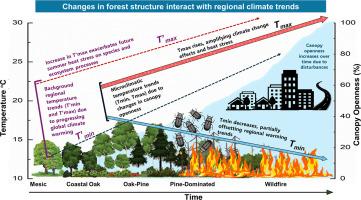Microclimate vulnerability under coupled effects of changing climate and forest structure
IF 5.7
1区 农林科学
Q1 AGRONOMY
引用次数: 0
Abstract
Understanding how forest structure affects microclimate is crucial amidst global warming, especially in biodiversity hotspots such as the North American Coastal Plain (NACP). We contrasted the effects of forest canopy openness and forest type on key microclimatic variables (daily temperature means, minima, maxima, amplitude) relative to their long-term temporal trends to better understand how forest structure may buffer the effects of changing climate in an important NACP ecosystem (the Long Island Central Pine Barrens). We analyzed 75 years of summer temperature trends (1949–2023) to reveal a dramatic regional warming by 2.3 °C on average, with daily minima increasing much more (by 3.3 °C) than daily maxima (by 1.4 °C), leading to the decline in daily temperature variability (amplitude) by ∼2 °C. We then quantified how late summer temperatures in forest understories (at ∼1 m above ground, in 2020) varied spatially with forest structure to reveal that increasing canopy openness (from ∼0 % to ∼80 %) increased daily maxima (by 2.5 °C) while decreasing daily minima (by -2.7 °C), thus considerably increasing daily temperature amplitude (by 5.1 °C). This effect was particularly pronounced in open-canopy pine-dominated ecosystems. Since forest canopies are expected to become more open under warmer climate due to drought-related tree mortality, lower tree recruitment, and increased fire, future summer daily temperature maxima in forest understories are likely to increase considerably more than predicted from regional temporal trends, while regional changes over time in daily minima (increase) and amplitude (decrease) may be offset in forest understories by changing forest structure.

气候变化与森林结构耦合作用下的小气候脆弱性
在全球变暖的背景下,了解森林结构如何影响小气候至关重要,尤其是在北美等生物多样性热点地区。
本文章由计算机程序翻译,如有差异,请以英文原文为准。
求助全文
约1分钟内获得全文
求助全文
来源期刊
CiteScore
10.30
自引率
9.70%
发文量
415
审稿时长
69 days
期刊介绍:
Agricultural and Forest Meteorology is an international journal for the publication of original articles and reviews on the inter-relationship between meteorology, agriculture, forestry, and natural ecosystems. Emphasis is on basic and applied scientific research relevant to practical problems in the field of plant and soil sciences, ecology and biogeochemistry as affected by weather as well as climate variability and change. Theoretical models should be tested against experimental data. Articles must appeal to an international audience. Special issues devoted to single topics are also published.
Typical topics include canopy micrometeorology (e.g. canopy radiation transfer, turbulence near the ground, evapotranspiration, energy balance, fluxes of trace gases), micrometeorological instrumentation (e.g., sensors for trace gases, flux measurement instruments, radiation measurement techniques), aerobiology (e.g. the dispersion of pollen, spores, insects and pesticides), biometeorology (e.g. the effect of weather and climate on plant distribution, crop yield, water-use efficiency, and plant phenology), forest-fire/weather interactions, and feedbacks from vegetation to weather and the climate system.

 求助内容:
求助内容: 应助结果提醒方式:
应助结果提醒方式:


